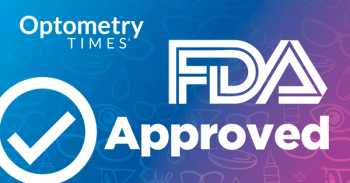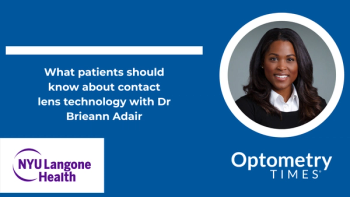
Treating dry eye with lipid-based eye drops
The lipid layer prevents evaporation of aqueous tears and prevents drying. Lipid deficiency due to meibomian gland dysfunction (MGD) is the most common cause of symptoms associated with dry eye disease.
Treating dry eye has become a significant part of practicing optometry, and many of us are seeing a growth in this part of our practices. Patient complaints of eyes that are dry, irritated, and uncomfortable will increase as the Baby Boomer population grows older and digital device use increases with associated reduced blink rate. It is estimated that 40 million people in the United States suffer from dry eye.1
The prevalence of dry eye varies based on parameters used to gather data and ranges from 14 percent for patients over age 48 in the U.S., to 25 percent in Canada, and 33 percent in Taiwan and Japan.2
Related:
Many aspects of dry eye are still not well understood, and its management can be challenging. Most, or perhaps nearly all, symptomatic forms of dry eye have an evaporative component,3 which likely contributes to aqueous tear loss through a defective lipid layer. This, in turn, can lead to increased osmolarity, ocular surface inflammation, and damage.
The meibomian glands in the eyelids secrete meibum, a lipid complex that forms the protective lipid layer of the tear film. The lipid layer prevents evaporation of aqueous tears and prevents drying. Lipid deficiency due to meibomian gland dysfunction (MGD) is the most common cause of symptoms associated with dry eye disease.3
Importance of the lipid layer
The function of the lipid layer has been studied extensively in recent years. While some believe that is merely a protective layer to prevent the aqueous tears from evaporating, recent studies show that the lipid layer is even more complicated; keeping the tear film intact, allowing it to spread across the ocular surface instead of collapsing.
This also keeps the tears flowing across the eye and into the puncta. Without this layer, the tear film cannot spread properly and worse yet, is then prone to evaporation.4
Treatment of meibomian gland dysfunction has traditionally been with the use of warm compresses, lid scrubs, and artificial tears. Adding a liquid to tears almost always provides initial relief of dry eye discomfort, but patients often complain that the relief is short lived. There are a number of lipid-containing eye drops on the market that are underutilized.
Related:
Using a lipid-containing artificial tear to help reform the protective layer of the tear film could give patients more relief from the collapse of the overall tear film and the evaporation of aqueous tears. One study shows that lipid-based tears are as safe, effective, and acceptable as aqueous-based artificial tears.5
As we gain a greater understanding of the layers of the tears, it makes sense that adding lipid eye drops to tears helps to recreate the protective and spreading function of the tears that the lipid layer provides. This may be more helpful than simply increasing the aqueous layer with artificial tears
Imaging the lipid layer
Recently, we have been measuring lipid layer thickness and observing the lipid layer with interference techniques. Using a stroboscopic microscope developed by Ewen King-Smith, PhD,6 we are able to not only measure the thickness of the lipid layer but also to view videos and visualize the thickness using a color scale.
Figures 1-5 are images we have taken of the lipid layer of a 62-year-old male patient with MGD. This patient had moderate MGD with visual fluctuations and has had comprehensive treatment in the past, including lid margin debridement and LipiFlow (TearScience) treatment several months ago.
He now uses Restasis (cyclosporine, Allergan) and a lipid-based eye drop once a day or less. We used our instrumentation to show the effects of these eye drops on his lipid layer. The initial image shows his lipid layer before any drops were instilled.
We used lipid-based artificial tears from four different manufacturers and measured the lipid thickness after the drops had been in the eyes for 15 minutes. Even after that period of time, the lipid layer was significantly thicker than before the eye drops were used. Mathematical analysis and photography both show great results in lipid layer enhancement.
Related:
As the lipid layer becomes thicker, the amount of colors present in the interferometry photos increases. Referencing the color scale on the right side of each picture, you can see that tears with more colors have a thicker lipid layer. Notice that the grey color indicated a lipid layer up to 80 nm.
This is most evident in the image taken before a lipid-based eye drop was used. Brown corresponds to thicknesses around 130 nm, while blue becomes apparent when the lipid layer reaches a thickness around 230 nm.
Striking improvements to the thickness of the lipid layer are evident. In these photos, it is easy to see the positive changes to the lipid layer of the tear film when lipid-containing drops are used.
Table 1 lists currently available over-the-counter (OTC) lipid-containing eye drops and their active ingredients. Why aren’t we recommending these lipid-based tears?
Of course, there are many other aspects to consider when treating our MGD patients and those with other types of dry eye.These patients may benefit from increased hydration-drinking more non-dehydrating liquids, avoiding low humidity, blinking more fully and consistently (yes, it can be taught), and eating a diet rich in omega-3 fatty acids.
If these measures don’t produce the desired results, prescribe anti-inflammatory eye drops such as steroid or antibiotic-steroid combinations to treat blepharitis-related inflammation or cyclosporine and oral antibiotics such as low-dose doxycycline as well as continued use of hot compresses. A complete treatment plan and adherence to the plan is required.
Our thanks to Matt Kowalski for assisting with image capture and analysis.
References:
1. Ding J, Sullivan DA. Aging and dry eye disease. Exp Gerontol. 2012;47(7):483–90.
2. Gayton JL. Etiology, prevalence, and treatment of dry eye disease. Clin Ophthalmol. 2009; 3: 405–412.
3. Nichols KK, Foulks GN, Bron AJ, et al. The international workshop on meibomian gland dysfunction: executive summary. Invest Ophthalmol Vis Sci. 2011 Mar 30;52(4):1922-9.
4. Millar TJ, Schuett BS. The real reason for having a meibomian lipid layer covering the outer surface of the tear film.- A review. Exp Eye Res. 2015 Aug;137:125-38.
5. Simmons PA, Carlisle-Wilcox C, Vehige JG. Comparison of novel lipid-based eye drops with aqueous eye drops for dry eye: a multicenter, randomized controlled trial. Clin Ophthalmol. 2015 Apr 15;9:657-6.
6. King-Smith, PE, Reuter KS, Begley CG, Braun RJ. Tear Film and Lipid Layer Structure in Relation to Four Phases of the Blink Cycle. Poster presented at: The Association for Research in Vision and Ophthalmology; 2014 May 4-8; Orlando, FL.
Newsletter
Want more insights like this? Subscribe to Optometry Times and get clinical pearls and practice tips delivered straight to your inbox.



















































.png)


